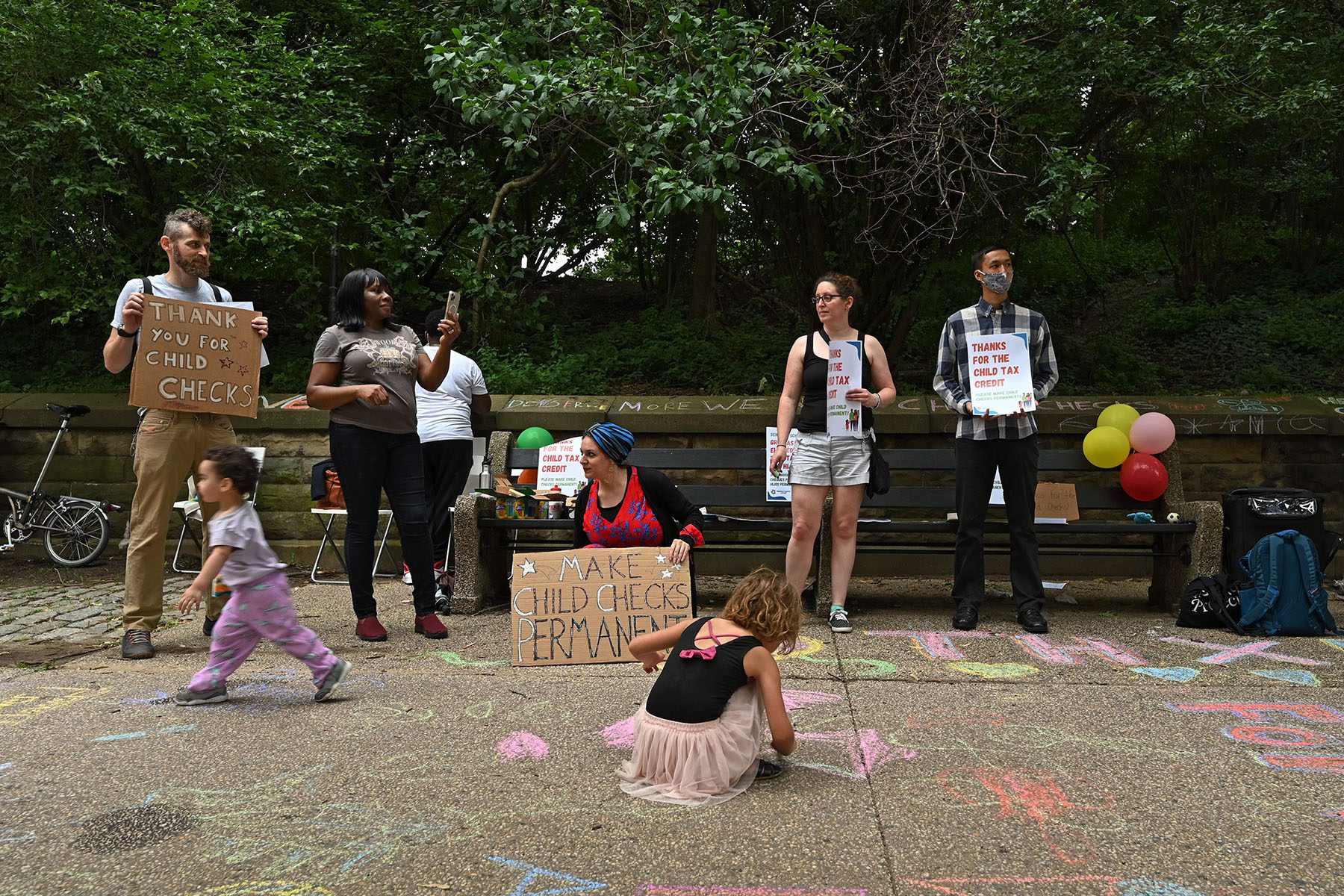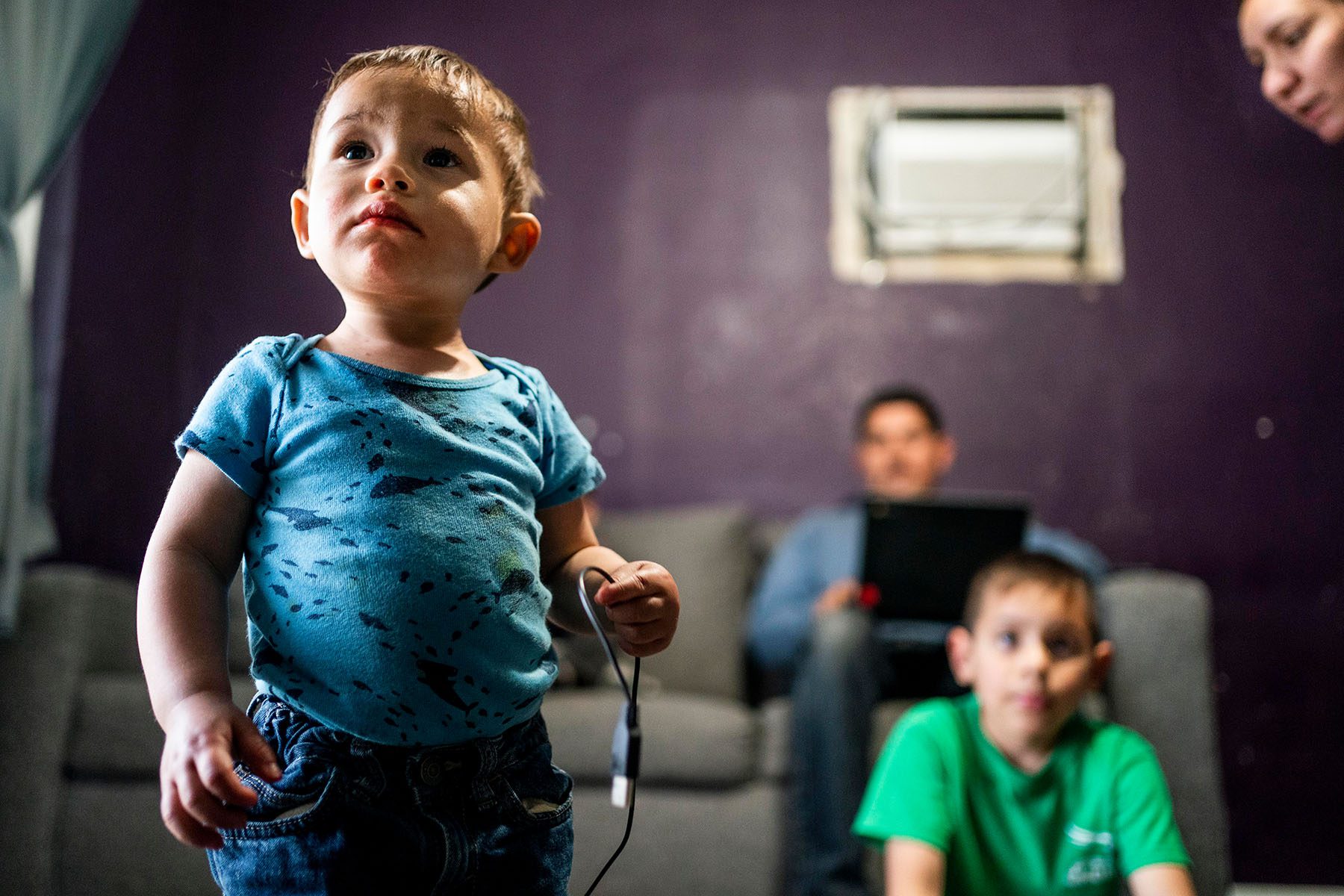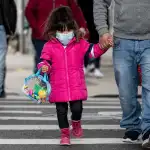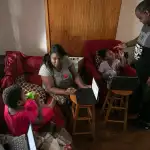For six months at the tail end of two tumultuous years, parents received direct payments — no strings attached — of as much as $300 per child in their bank accounts. By many accounts, that money delivered long-awaited relief for 61 million children, dropping rates of poverty and hunger.
This week will mark the first time since July that parents will go without a monthly payment.
The expanded child tax credit fell short of some of its biggest promises: It didn’t quite cut the child poverty rate in half, and millions of the most vulnerable families were still left out of receiving money. The full potential of the credit hinged on extending the new benefits permanently, advocates say — it was never expected to cut child poverty in just six months.
Now, the future of the credit hangs in the balance now as Congress debates whether to include any form of a permanent expansion in the Democrats’ Build Back Better package. Those negotiations are taking place as parents brace for another wave of COVID-19 cases that could shutter schools, limit job opportunities and undo some of the financial breathing room the credit created.
When the credit worked best this year, parents could count on it to manage the soaring cost of child care, pay for food, or cover the unexpected expenses that piled up during the pandemic, like the ones Rosa Walker’s family faced.
From July to December, the Oregon mom of three received $800 a month. It was one of the only moments when the pressure of the pandemic eased: She and her husband were forced to cut back hours at work, and the health of her entire family had suffered — she took six months to recover from COVID-19, her boys struggled with their mental health and her husband broke a rib in a roofing accident. When the new credit first arrived last summer, they had $10,000 in new credit card debt from trying to keep the wheels turning since the start of 2020.
With the credit, the family was able to cover higher child care costs for their 4-year-old. They were also able to budget for opportunities to enrich their children’s lives, allowing her 8- and 10-year-old to go to soccer. Walker, an early intervention occupational therapist who works with young children, said being able to provide those social supports helped ease some of the trauma of the pandemic for her children.

“For me, it’s so clear that this is where to invest, not just because these are going to be our adult leaders, but because they deserve the best as children right now,” she said.
The one-year expansion of the child tax credit through Congress’s coronavirus relief plan of early 2021 was modified to remove an income requirement so that the poorest families in the country, the majority of them Black and Latinx, could access the full amount. It changed the structure to a monthly stipend instead of an annual lump sum. The amount also went up, from a maximum of $2,000 to $3,600, and divvied up in payments from July to December of $300 each for kids under 6, and $250 each for kids 6 to 17. The second half of the payments will come in with taxes this year — if parents are able to successfully claim them. The Internal Revenue Service is expected to face significant pandemic-induced backlogs this filing season.
Many Democrats, the White House and advocates expected the policy to be extended beyond a one-year expansion — but that has now been reduced to little more than a pipe dream. Sen. Joe Manchin of West Virginia, who has been the loudest Democratic opponent to the credit, has said he will not support Congress’s Build Back Better plan, an economic package that includes a permanent expansion of the child tax credit, specifically because he believes that credit should be modified so higher-income families are excluded with an additional requirement that parents be working to receive the money.
Those changes will be major concessions for the Democrats who have pushed for the credit expansion, and time is running out to reach a deal. If the expansion does not become permanent, the child tax credit will revert to what it was before: An annual allowance capped at $2,000 — instead of the $3,600 maximum now per child — that was not available to the poorest families in full.
“It’s almost harder to have [the child tax credit] and have it taken away,” Walker said.
Walker fears the impact of that decision could affect families years later, in tangible ways like less access to nutritional food or enough food at all, and in more intangible ways like the impact of parents’ stress on their family.
“I know as a country we really value children, even if it can sometimes feel like we don’t, but I also think children and families aren’t always the loudest voices and I think it can be very easy to miss the impact of not moving forward with this until much later,” she said.
To understand the impact of the child tax credit, it’s important to measure what it was able to do in six months — and where it fell short.
In July, when the first payments went out, the IRS was able to reach 59.3 million children — about 88 percent of all kids in the country — and it increased that amount in subsequent months to more than 61 million.
A study by the Columbia Center on Poverty and Social Policy found that between 3 and 3.8 million children were kept from poverty because of the payments from July to November, at which point the monthly child poverty rate had dropped by 29 percent. The most significant impacts were on Black and Latinx children. By November, Black child poverty had shrunk by 26 percent, and the Latinx child poverty rate was down 30 percent, the center found.
Prior to the expansion, 1 in 2 children of color were not getting the full credit, compared to 1 in 4 White children. These kids were also more likely to need the credit for fundamental needs like food. (Black and Latinx kids experience twice the rate of food insufficiency — a more severe form of food insecurity that measures whether a family has enough to eat — as White children.)
According to survey data from the Census Bureau, most parents who received the child tax credit were likely to spend it rather than save. Food topped the list, followed by essential bills, clothing, housing and school expenses. About 21 percent of parents used the money to pay down debt and about 17 percent saved it, per an analysis from July to August by the Social Policy Institute at Washington University in St. Louis.
The funds were essential for parents like Karla McKinnie, a single mother in Detroit with a 10-year-old and 11-year-old. McKinnie lost her job as a server during the pandemic and was out of work for about six months in 2020, putting her behind on bills and rent. A job she took on as a caregiver for older people while she was out of work helped, but the work was sporadic.
The tax credit during the past year helped her pay the rent on time and provide WiFi for her kids so they could continue to do virtual learning.

“Being a single mom and living check to check — actually day to day, for me — just being able to have that reassurance that it was coming on the 15th [of every month], it made me stress out a lot less,” McKinnie said. “I knew that we would have groceries and it would be OK for me to go grocery shopping and get everything that we needed.”
She also used some of the money to put her daughter in guitar lessons. Now with the credit coming to an end, she is looking back at a time of scarcity.
“It’s back to paying for the necessities,” she said.
The greatest poverty-reducing power of the child tax credit was held in its ability to reach the people who had never received the full credit before — families that earned nothing at all or too little to file an income tax, or grandparents or parents with disabilities on a fixed income.
But many of those families weren’t reached at all, or only received partial payments. Researchers previously estimated that about 4 million children were at risk of not receiving the payments because their parents hadn’t filed taxes, would need to take additional steps to do so or faced language or technological barriers. They were most likely to be Black or Latinx kids in the lowest-income families in the nation.
The IRS initially sent automatic payments to anyone who had filed a tax return in 2019 or 2020 or signed up through the IRS for a coronavirus stimulus payment. Families who didn’t fall into that category and were earning under $24,800 as a family could sign up for the child tax credit through a simplified form in a portal the IRS set up in June, prior to the start of the first payments.
That sign-up process was cumbersome: The application was confusing, available only in English and did not come in a mobile phone version (low-income people are far more likely to have a phone than a laptop). A new portal in partnership with tech nonprofit Code for America became widely available in September, offering a simplified application that was mobile-friendly and available in Spanish.
More than 100,000 people signed up through that new portal, said Gabriel Zucker, associate policy director for the tax benefits team at Code for America. Most took about 10 minutes to get through the application and the majority used it on their phones. About 4 in 5 users said it was easy or extremely easy to use, he said.
Code for America also helped market the website through benefits agencies, allowing people who didn’t file taxes but did receive some kind of government assistance to become aware of the option.
Realistically though, they never expected to be able to capture everyone in the first year of a program — one of the reasons why Zucker believes an extension of the child tax credit will help it get closer to reaching its original objective.
“What we have shown is that this population can be reached, but it’s going to take time to get to everyone,” he said.
The delays in setting up the portals meant newly eligible families had less time to sign up, and much of the on-the-ground outreach effort was taking place at the community level by small organizations that were overwhelmed with clients.
Families where one family member was an undocumented immigrant with a tax filing number did not receive any payments in July, for example, because of a glitch in the IRS system. Many of those families got the money in two portions in August instead, but others reported never receiving it.
The same happened with parents of newborns who never got the option to claim those children for child tax credit payments this year, said Elaine Maag, a principal research associate at the nonpartisan Tax Policy Center.
“It’s always the case that people that already face the most burdens and complexity in their lives have the least access to the services that are available,” Maag said.
On the ground, agencies helping people sign up for the credit reported a wide swath of problems, including tax forms that were filled out incorrectly by reputable organizations, absent parents who were wrongfully claiming the children instead, and credits that were marked as “issued” even though parents never received the money.
Melanie Malherbe, managing attorney of the welfare law unit at Greater Boston Legal Services, helped sign up low-income families through the portal. She said her caseload was immense — and complicated. Even for her, a trained lawyer, trying to get answers from the IRS and sorting through filing information was challenging, Malherbe said.
“What I’ve observed is that the program could be great — if it was extended. Look at the impact it’s already had on children in poverty,” she said. “But there is an additional level of help and resources needed to extend to people in deep poverty that doesn’t exist.”
The real-life impact of that is that families who expected to get a cash infusion were left in limbo.
Katie Walden and her family saw the upcoming arrival of the credit as an opportunity. Her husband had spent the pandemic trucking to keep the family afloat, work that was on a contract basis, low paid and required punishingly long hours. With the credit coming, they could afford for him to take a lower-paying job that was more stable, they thought.

The Waldens, who have a 3-, 7- and 9-year-old, should have received about $800 — they were eligible for the money and had received it in the past. But the credit never arrived. They couldn’t understand why. In September, they received what they thought was a back payment of $1,000, and then in October their status changed from “eligible” to “pending.” No one at the IRS could tell Walden what had happened.
“It took away the opportunity of feeling fulfilled and feeling like you can be out of panic mode,” Walden said. “I think people don’t really understand what it’s like to put groceries back or say, ‘We can’t get strawberries because they are not on sale.’ To have children have an understanding of, ‘Oh, we are poor,’ that’s really hard to deal with.”
They plan to claim the full amount this year in their taxes, but that money will now go into paying back their parents, who helped them with expenses when the credit didn’t arrive.
“It’s just that demoralizing thing every time you have to ask for help, and we wouldn’t have had to ask for help if it would have worked out,” Walden said.
The future of the child tax credit seems to hinge on two major proposed changes to the policy: the introduction of a work requirement and a lower income cap.
While prominent advocates for the expansion say they may be willing to discuss some specific details of the plan, many are adamant that it is functioning as intended. Rep. Rosa DeLauro, the credit’s longtime champion, said in a statement to The 19th that “there is no need to be negotiating on the design.”
“What I am laser focused on is the consequences for the families that are harmed by the lack of extension,” DeLauro said, adding that she is optimistic “we can get the child tax credit over the finish line.”
Sen. Michael Bennet, who has also pushed for the credit’s expansion, said told The 19th that Congress has “to find a way to extend it, and I’ll continue to look for any opportunity to do so.”
Still, tax policy experts worry that the proposed changes to the program can make it even less accessible to the families who need it the most, negating the landmark changes that were implemented last year.
Megan Curran, the policy director at Columbia’s Center on Poverty and Social Policy who wrote the report analyzing the monthly payments, said that a work requirement, in particular, would erase some of the gains of a program redesigned specifically for poverty reduction.
The former version of the child tax credit had income minimums for parents to qualify, which rose depending on how many kids were in the family. That resulted in about a third of children not accessing the credit, including half of all Black and Latinx kids whose parents were more likely to fail to meet the income requirements.
“I find it very difficult to make an argument as to why we should be able to return to that when we have been able to fix many of those issues,” Curran said.
Already, more than 95 percent of people who receive the tax credit are working or were recently working, a grandparent caring for a child, a person with a disability who is not working, or a parent of a very young child under 2 who has stopped working.
Studies of the credit have found no evidence it is leading people to stop working, and one study on census data by researchers at Washington University and Appalachian State University found that the rates of parents reporting they are unemployed to care for kids dropped from 26 percent to 20 percent after the credit went out, suggesting parents were using the funds on child care.
The question of changing the income cap has also been a point of contention for some time, with people including Manchin arguing that the program should not in any way help support higher income families. Currently, couples earning up to $400,000 or individuals earning up to $200,000 qualify for a smaller portion of the child tax credit, maximums were instituted during 2017 tax law changes.
Curran argues that the central point of the program was to help kids, regardless of parent’s income status. As the pandemic has shown, that income status can also swing quickly and suddenly.

“It’s meant to be for kids. I think it makes sense that it’s available largely regardless of family economic circumstance,” she said. “There’s not all of a sudden these cliffs that happen if you earn $100 more at a certain point or $1,000 more at a certain point, you lose this.”
The debate over how to incorporate either of the changes Manchin is requesting, however, is still fairly nebulous. It’s unclear what kind of compromise Democrats are considering, and whether it will even be enough.
Meanwhile, the second half of child tax credit payments still need to reach American households. The IRS has begun sending a letter to parents that contains the amount they will need to claim in their 2021 taxes to get their full share, but that process will face its own set of hurdles reaching families who have moved, or who may not have a permanent address.
“That will be confusing for a lot of families — it’s always confusing when the IRS sends a piece of mail to you,” said Maag at the Tax Policy Center. “You are going to have a lot of people who have not interacted with the tax system previously who are going to have to interact with it.”
One thing that may be more readily available this year will be tax filing sites that will open to coincide with the tax season, but because of the pandemic and a rise in Omicron variant cases, it’s likely those sites will be overwhelmed as it is.
And, Malherbe pointed out, the cases of the most vulnerable families are also the most complicated and sites may not have the resources to help people through the process.
Without that aid, something that can’t be added in one year but could in subsequent years if the program was extended, she said, the tax credit’s potential will continue to be stunted.
“I am worried that some of the people who completely have not gotten anything for their kids yet are not going to get it unless there is the kind of level of help we’ve been giving,” Malherbe said. “There are just a lot of potential pitfalls.”
Correction: The 19th has clarified Rep. Rosa DeLauro's stance on negotiations over details of the plan.







